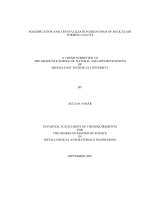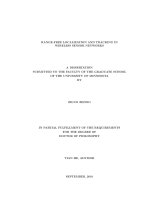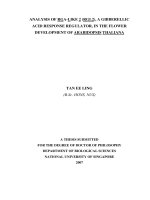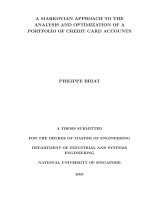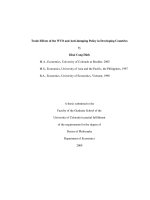A Thesis Submitted to the Graduate Facultyof theNorth Dakota State Universityof Agriculture and Applied Science
Bạn đang xem bản rút gọn của tài liệu. Xem và tải ngay bản đầy đủ của tài liệu tại đây (1.57 MB, 154 trang )
ECONOMIC ASSESSMENT
OF WETLAND MITIGATION IN MINNESOTA
A Thesis
Submitted to the Graduate Faculty
of the
North Dakota State University
of Agriculture and Applied Science
By
Robert Loyal Sip
In Partial Fulfillment of the Requirements
for the Degree of
MASTER OF SCIENCE
Major Program:
Natural Resources Management
Major Department:
Agricultural Economics
February 1998
Fargo, North Dakota
ABSTRACT
Sip, Robert Loyal, M.S., Department of Agricultural Economics, College of Agriculture,
North Dakota State University, February 1998. Economic Assessment of Wetland
Mitigation in Minnesota. Major Professor: Dr. Jay A. Leitch.
The economic efficiency of wetland mitigation in Minnesota’s Red River Valley was
examined using the Minnesota Routine Assessment Method on ten wetland case studies to
rate the functions of impacted and replacement wetlands. Secondary sources were used to
assign dollar value to wetland functions of impacted and replacement wetlands. Mitigation
costs for projects ranged from $279 to $4,171 per acre. Estimated social values ranged
from $207 to $1,027 per acre for impacted wetlands and from $268 to $927 per acre for
replacement wetlands. Social values of replacement wetlands exceeded the social value of
impacted wetlands in seven cases. Values of replacement wetlands were 1.8 to 4 times
greater than the values of impacted wetlands due to 2 to 1 replacement ratios. When
society gains benefits from mitigation, then public cost sharing may be appropriate. In one
case, the value of the impacted wetland was higher than the value of the replacement
wetland. There were insufficient data to evaluate two cases. Results are only indicators of
efficiency, since not all social costs and benefits of the impact-mitigation activity are
addressed by legislation. These results suggest wetland mitigation policy in Minnesota
should be reevaluated if efficient use of society’s resources is a legislative goal.
ACKNOWLEDGMENTS
I would like to thank Donald Ogaard and the Red River Watershed Management Board
for financial support for this research and for the professionalism that this organization
contributes to the natural resources management field. A sincere thanks goes to Dr. Jay A.
Leitch for his integrity and sincerity as an adviser and instructor and for the countless
reviews of this thesis. Thanks also go to my other committee members: Drs. Donald R.
Kirby, William C. Nelson, and Walter D. Svedarsky, who provided valuable insight and
whose comments and suggestions were greatly appreciated.
I would also like to thank the following personnel from the Minnesota Board of Water
and Soil Resources: John Jaschke, Wetland Conservation Act program manager of the
central office, who helped to interpret the various aspects and policy of the Minnesota
Wetland Conservation Act; Brian Dwight, board conservationist of the Bemidji field
office, who helped to apply the Minnesota Routine Assessment Method to the study
wetlands; Bill Best, board conservationist of the Bemidji field office; and Dan Eklund,
wetland specialist of the Brainerd field office, for identifying case studies. Charles Fritz of
North Dakota State University also helped to apply MNRAM to the study wetlands, and
his knowledge and suggestions were quite helpful.
Also, thanks go to the various Minnesota Soil and Water Conservation District, Local
Governmental Unit, Natural Resources Conservation Service, Minnesota Watershed
District, and Houston Engineering personnel who helped to identify wetland case studies.
i
DEDICATION
This thesis is dedicated to my loving wife, Amy, whose patience and understanding
throughout my college career has been unending. Her constant encouragement and kind
words guided me through many long hours of preparing for examinations and assignments.
Her presence by my side throughout this graduate school experience was comforting.
Thank you, I love you.
R.L.S.
ii
TABLE OF CONTENTS
ABSTRACT ........................................................................................................................ iii
ACKNOWLEDGMENTS .................................................................................................. iv
DEDICATION ..................................................................................................................... v
LIST OF TABLES ............................................................................................................. xii
LIST OF FIGURES .......................................................................................................... xiii
LIST OF ACRONYMS .................................................................................................... xiv
CHAPTER 1. INTRODUCTION ....................................................................................... 1
Need for Study ......................................................................................................... 4
Objective .................................................................................................................. 5
Procedure ................................................................................................................. 5
Organization ............................................................................................................. 5
CHAPTER 2. ECONOMIC BACKGROUND .................................................................. 7
Social Value Philosophy .......................................................................................... 7
Wetland Economics ................................................................................................. 9
Efficiency and Maximum Social Well-being .............................................. 9
Market Failure ............................................................................................ 11
CHAPTER 3. WETLAND REPLACEMENT .................................................................. 15
Wetland Conservation Act Mitigation Policy ........................................................ 15
In-kind Replacement and Out-of-kind Replacement ................................. 18
Wetland Replacement Ratios ..................................................................... 21
No-net-loss ................................................................................................. 21
Mitigation Banking .................................................................................... 22
iii
Wetland Exemptions and de minimis ......................................................... 23
Improving Decision Making .................................................................................. 24
CHAPTER 4. MINNESOTA ROUTINE ASSESSMENT METHOD
FOR EVALUATING WETLAND FUNCTIONS ............................................................. 25
General Information ............................................................................................... 25
Scope and Limitations ........................................................................................... 26
Wetland Classification ........................................................................................... 26
Summary of Wetland Functions ............................................................................ 27
Site Description ...................................................................................................... 27
Functional Assessment .......................................................................................... 28
Floral Diversity and Integrity .................................................................... 29
Wildlife Habitat ......................................................................................... 29
Fishery Habitat ........................................................................................... 31
Flood and Stormwater Storage .................................................................. 32
Water Quality Protection ........................................................................... 37
Shoreline Protection ................................................................................... 39
Groundwater Interaction ............................................................................ 40
Aesthetics, Recreation, and Education ...................................................... 43
Commercial Uses ....................................................................................... 43
User Guidance ........................................................................................................ 45
Implications of the Minnesota Routine Assessment Method ................................ 45
CHAPTER 5. PROCEDURE ............................................................................................ 46
Site Selection ......................................................................................................... 48
iv
Secondary Data ...................................................................................................... 48
Field Visits ............................................................................................................. 52
Technical Evaluation Panel Results ....................................................................... 53
Mahnomen County Impacted Wetland .................................................................. 54
Functional Assessment of Impacted Wetland ........................................................ 55
Floral Diversity and Integrity .................................................................... 56
Wildlife Habitat ......................................................................................... 56
Fishery Habitat ........................................................................................... 56
Flood and Stormwater Storage .................................................................. 57
Water Quality Protection ........................................................................... 58
Shoreline Protection ................................................................................... 58
Groundwater Interaction ............................................................................ 58
Aesthetics, Recreation, and Education ...................................................... 59
Commercial Uses ....................................................................................... 59
Mahnomen County Replacement Wetland ............................................................ 59
Functional Assessment of Replacement Wetland .................................................. 61
Floral Diversity and Integrity .................................................................... 61
Wildlife Habitat ......................................................................................... 62
Fishery Habitat ........................................................................................... 62
Flood and Stormwater Storage .................................................................. 63
Water Quality Protection ........................................................................... 63
Shoreline Protection ................................................................................... 64
Groundwater Interaction ............................................................................ 64
v
Aesthetics, Recreation, and Education ...................................................... 64
Commercial Uses ....................................................................................... 65
Monetary Valuations .............................................................................................. 65
Floral Integrity and Diversity .................................................................... 66
Wildlife Habitat ......................................................................................... 66
Fishery Habitat ........................................................................................... 68
Flood and Stormwater Storage .................................................................. 68
Water Quality Protection ........................................................................... 69
Shoreline Protection ................................................................................... 69
Groundwater Interaction ............................................................................ 71
Aesthetics, Recreation, and Education ...................................................... 71
Commercial Uses ....................................................................................... 72
Mitigation Costs ..................................................................................................... 73
CHAPTER 6. RESULTS .................................................................................................. 76
Mahnomen County Wetland Case Study Results .................................................. 76
Floral Diversity and Integrity .................................................................... 76
Wildlife Habitat ......................................................................................... 78
Fishery Habitat ........................................................................................... 78
Flood and Stormwater Storage .................................................................. 78
Water Quality Protection ........................................................................... 79
Shoreline Protection ................................................................................... 79
Groundwater Interaction ............................................................................ 80
Aesthetics, Recreation, and Education ...................................................... 80
vi
Commercial Uses ....................................................................................... 80
Mitigation Costs ..................................................................................................... 81
Estimated Annual Monetary Values of Case Study Wetlands .............................. 82
Other Wetland Case Study Results ........................................................................ 84
Becker County Wetland ............................................................................. 84
Clay County Wetland Case Study ............................................................. 85
Clearwater County Wetland Case Study ................................................... 86
Kittson County Wetland Case Study ......................................................... 87
Mahnomen County Wetland Case Study (Waubun) .................................. 87
Red Lake County Wetland Case Study ...................................................... 88
Roseau County Wetland Case Study (County Road 8) ............................. 89
Marshall County Wetland Case Study ....................................................... 90
Roseau County Wetland Case Study (County Road 6) ............................. 91
Findings ................................................................................................................. 91
CHAPTER 7. CONCLUSIONS AND IMPLICATIONS ................................................. 93
Sensitivity of Results ............................................................................................. 93
Policy Implications ................................................................................................ 95
Wetland Monitoring ................................................................................... 97
Minnesota Routine Assessment Method .................................................... 98
Wetland Replacement Ratios ..................................................................... 98
Road Construction Projects ....................................................................... 99
Local Governmental Unit Administration ............................................... 100
Research Needs .................................................................................................... 100
vii
REFERENCES CITED .................................................................................................... 102
APPENDIX A. MINNESOTA ROUTINE ASSESSMENT METHOD FOR
EVALUATING WETLAND FUNCTIONS ................................................................... 113
viii
LIST OF TABLES
Table
Page
1
Draft 1996 Minnesota Wetland Report .................................................................... 4
2
Selected Economic Evaluations of Wetlands .......................................................... 8
3
Wetland Flood Control Values .............................................................................. 36
4
Wetland Case Studies ............................................................................................ 49
5
Importance of Wetlands in Minnesota, Estimates of Wetlands Contributions
to the States’s Welfare……………………………………………………………..67
6
Costs Associated With Producing Wetland Hay ................................................... 73
7
Wetland Mitigation Costs in Minnesota ................................................................ 74
8
Per Acre Dollar Values for Minnesota Routine Assessment Method
Wetland Functions ................................................................................................. 75
9
Minnesota Routine Assessment Method for Evaluating Wetland Functions,
Ten Case Studies .................................................................................................... 77
10 Annualized Costs of Mitigation Projects (In 1996 Dollars) .................................. 82
11 Estimated Annual Monetary Values of Impacted and Replacement Wetlands,
by Function (In 1996 Dollars) ............................................................................... 83
ix
LIST OF FIGURES
Figure
x
Page
1
Location of Study Area, Red River Valley .............................................................. 6
2
Production Possibilities Curve, Indifference Curve, and Point of Maximum
Social Well-being .................................................................................................. 10
3
Minnesota Wetland Areas ...................................................................................... 19
4
Prairie Pothole Region of the United States and Canada ....................................... 30
5
Red River Basin of Minnesota, North Dakota, and South Dakota Flowing
North into Canada .................................................................................................. 33
LIST OF ACRONYMS
BCIWL
Becker County Impacted Wetland
BCRWL
Becker County Replacement Wetland
BWSR
Board of Water and Soil Resources
CCIWL
Clay County Impacted Wetland
CCRWL
Clay County Replacement Wetland
CLCIWL
Clearwater County Impacted Wetland
CLCRWL
Clearwater County Replacement Wetland
CPI
Consumer Price Index
DNR
Department of Natural Resources
HGM
Hydrogeomorphic Method
IC
Indifference Curve
IWL
Impacted Wetland
KCIWL
Kittson County Impacted Wetland
KCRWL
Kittson County Replacement Wetland
LGU
Local Governmental Unit
MACIWL
Marshall County Impacted Wetland
MACRWL
Marshall County Replacement Wetland
MCIWL
Mahnomen County Impacted Wetland
MCRWL
Mahnomen County Replacement Wetland
MCWIWL
Mahnomen County (Waubun) Impacted Wetland
MCWL
Mahnomen County Wetland
MCWRWL
Mahnomen County (Waubun) Replacement Wetland
xi
MNRAM
Minnesota Routine Assessment Method
MWCP
Minnesota Wetlands Conservation Plan
NRCS
Natural Resources Conservation Service
NWI
National Wetland Inventory
PPC
Production Possibilities Curve
PPR
Prairie Pothole Region
RCIWL
Roseau County Impacted Wetland (Road 6)
RCRWL
Roseau County Replacement Wetland (Road 6)
RLCIWL
Red Lake County Impacted Wetland
RLCRWL
Red Lake County Replacement Wetland
ROCIWL
Roseau County Impacted Wetland (Road 8)
ROCRWL
Roseau County Replacement Wetland (Road 8)
RRV
Red River of the North Valley
RRWMB
Red River Watershed Management Board
RWL
Replacement Wetland
SWCD
Soil and Water Conservation District
TEP
Technical Evaluation Panel
USACOE
United States Army Corps of Engineers
WCA
Wetland Conservation Act
WTP
Willingness-To-Pay
xii
CHAPTER 1
INTRODUCTION
Wetland ecosystems are comprised of diverse floral and faunal communities which provide
society with biological, hydrological, and educational benefits. Despite these recognized
benefits, wetland ecosystems have been considered wasted space and have been drained or filled
for agricultural development, urban uses, and highway systems. Because of these conflicting
beliefs, wetland management has been a highly controversial issue in the United States,
especially in the Prairie Pothole Region (PPR) of the Upper Great Plains (Baltezore et al. 1987).
Issues being addressed by policymakers include the social value of wetlands and wetland
acres/types needed to sustain ecosystem health. Until these issues can be resolved, the wetland
debate will continue. Wetlands, like other normal economic goods, can always be used if
demand exists and the next best alternative does not exist (Leitch and Baltezore 1992).
Regionally, the social value and management of wetlands have been issues of concern in
Minnesota. The Minnesota Wetland Conservation Act (WCA), signed into law by Governor
Arne H. Carlson on June 4, 1991, was enacted to help manage the state’s wetlands.
Terms such as attributes, benefits, characteristics, features, functions, outcomes, outputs,
services, social value, and value are used throughout the wetland literature. It is important to
clearly distinguish among these terms. Attributes, characteristics, and features are physical
components of wetlands such as size, depth, location, hydrology, vegetation, and water
chemistry. Functions are the biological and chemical processes that occur in wetlands such as
nutrient assimilation and groundwater recharge/discharge (King and Herbert 1997). Benefits,
outcomes, outputs, and services are consumptive or non-consumptive services produced by
wetlands such as flood control reduction, environmental education, visual aesthetics, water table
2
maintenance, and wildlife. Social value and/or value represent the worth of wetland benefits,
outcomes, outputs, and services to society. Values are the willingness-to-pay (WTP) of
individuals or society for benefits, outcomes, outputs, and services of wetlands (King and
Herbert 1997).
Wetlands can provide many benefits to society, and policymakers have been able to
recognize the importance of sustaining Minnesota’s wetland areas. In Minnesota, WCA
(Minnesota Board of Water and Soil Resources 1993, WCA Statutes, p. 2) states:
The legislature finds that the wetlands of Minnesota provide public value by
conserving surface waters, maintaining and improving water quality, preserving
wildlife habitat, providing recreational opportunities, reducing runoff, providing for
floodwater retention, reducing stream sedimentation, contributing to improved
subsurface moisture, helping moderate climatic change, and enhancing the natural
beauty of the landscape, and are important to comprehensive water management.
The intent of WCA is to “conserve and use water resources of the state in the best interests of its
people, and to promote the public health, safety, and welfare” (Minnesota Board of Water and
Soil Resources 1993, WCA Statutes, pp. 1-2). “Economic considerations alone do not justify
adversely affective actions” (Minnesota Board of Water and Soil Resources 1996, WCA Rules,
Chapter 8420, p. 5). WCA was designed to be used at the local level to protect wetland
ecosystems.
WCA is comprised of administrative rules and regulations to conserve wetland areas of the
state. The Minnesota Board of Water and Soil Resources (BWSR), as delegated by the
Minnesota legislature, is primarily responsible for implementing and overseeing WCA, issuing
administrative rules for WCA, and acquiring permanent easements for wetland Types I, II, and
III. WCA states that “wetland type” means a wetland type classified according to Shaw and
Fredine (1956). Local government units (LGU or LGUs) such as county highway departments,
3
planning and zoning offices, solid waste offices, and Soil and Water Conservation Districts
(SWCD or SWCDs) have the primary responsibility to administer WCA, while the Minnesota
Department of Natural Resources (DNR) is responsible for statewide enforcement of WCA. The
DNR may issue cease and desist orders and may also issue restoration and replacement orders
when violations occur according to Minnesota Statute S 103G.2372 (Minnesota BWSR 1993).
Public perception of what comprises a wetland often leads to confusion because many
definitions have been developed since the early eras of wetland management. Interpretations in
the past have led to various opinions among policymakers. According to WCA, “wetlands means
lands transitional between terrestrial and aquatic systems where the water table is usually at or
near the surface or the land is covered by shallow water” (Minnesota BWSR 1993, WCA
Statutes, p. 26). The Minnesota BWSR (1993, WCA Statutes, p. 26) describes the attributes that
are part of a wetland.
For purposes of this definition, wetlands must have the following three attributes:
(1) have a predominance of hydric soils, (2) are inundated or saturated by surface or
ground water at a frequency and duration sufficient to support a prevalence of
hydrophytic vegetation typically adapted for life in saturated soil conditions, and (3)
under normal circumstances, support a prevalence of such vegetation.
Need for Study
The Minnesota Wetlands Conservation Plan (MWCP) was developed to guide the
stewardship of wetlands of the state (Minnesota DNR 1997). Research priorities identified in the
MWCP include an economic evaluation of wetland mitigation (Minnesota DNR 1997). The
economics of wetland mitigation is a concern to policymakers, LGUs, society, and developers.
A primary issue is that some naturally occurring wetlands may have limited social value. When
an impact occurs, the natural wetland must be replaced by another wetland of at least equal size
4
and social value (Minnesota BWSR 1996). Mitigation expenses may exceed the wetland’s social
value, and/or the result may be a restored wetland that has greater or lesser value than the
original natural wetland. The social values of impacted and replacement wetlands should be
considered in mitigation plans so efficient uses are made of society’s scarce resources. BWSR
estimated that expenditures exceeded $2.8 million in 1996 to administer WCA (Table 1). While
it is difficult to allocate these expenses to specific wetlands, the $2.8 million roughly averages
about $700 per acre “saved” in 1996.
Table 1. Draft 1996 Minnesota Wetland Reporta
Acres
Avoided
Acres
Minimized
Acres
Drained
or Filled
Acres
Replaced Via
Replacement
Plans
Estimated
Wetland Acres
Impacted Via
Exemptions
Total
Administrative
Expenses for WCA
in 1996
3,547
761
555
528
356
$2,827,747
In 1996, there were 240 replacement projects, 1004 exemptions approved, 976 No-Loss
determinations, and 93 restoration orders (Source: Jaschke, John. 1998. Draft 1996 Minnesota
Wetland Report. Minnesota Board of Water and Soil Resources, St. Paul).
a
Objective
The objective of this study was to assess the economic efficiency of Minnesota’s WCA
mitigation policy from society’s perspective. It was assumed that individuals who impact
wetlands and comply with mitigation requirements made rational decisions to do so.
Procedure
The study was conducted in the Red River Watershed Management Board (RRWMB)
jurisdictional area (Figure 1). Ten wetland mitigation projects were identified. The working
hypotheses were (1) that some impacted wetlands have social values less than the cost to replace
them and (2) that some restored or created mitigation wetlands have social values less than their
5
restoration or creation cost. Wetland functions of impacted wetlands were compared to functions
of mitigated wetlands using the Minnesota Routine Assessment Method (MNRAM). Where
differences in functions occurred between impacted and mitigated wetlands, the differences were
evaluated using dollar values from the literature. By viewing and contrasting the differences
between impacted and mitigation wetland values, the efficiency of mitigation was assessed.
Organization
This chapter introduced the problem, the need for the study, the objective, and the study
procedures. Chapter 2 reviews wetland values and economic concepts. Chapter 3 describes
wetland replacement guidelines. Chapter 4 describes MNRAM and discusses wetland functions.
Chapter 5 describes the study procedure. Chapter 6 presents the results of the economic
assessment of ten wetland case studies. Chapter 7 includes conclusions, implications, and
recommendations and identifies the need for further study of wetlands in Minnesota.
6
Figure 1. Location of Study Area, Red River Valley (Source: Sinn, Mel. 1998. Personal
communication. Surface water and hydrographics administrator, Division of Waters, Minnesota
Department of Natural Resources, St. Paul).
7
CHAPTER 2
ECONOMIC BACKGROUND
Wetland science is an evolving discipline that has often been used to interpret the role of
wetlands in natural and social systems. The debate over the importance and social value of
wetlands continues as economists attempt to quantify wetland outputs using monetary valuation
methods. Many wetland valuation methods exist. However, economic methods can result in
wide-ranging estimates (Table 2). Accurate monetary valuations of PPR wetlands depend on (1)
successful simulation of the wetland ecosystem, (2) identification of individuals who derive
benefits from wetland products and services, and (3) the ability to estimate those benefits
(Nelson and Leitch 1983).
Social Value Philosophy
The social philosophy that underlies wetland preservation and conservation is that of human
value and ethics. Humans make ethical decisions and place value on something (e.g., wetlands)
that is important, whether it is culturally or aesthetically pleasing. Economic values are derived
from human wants, which are felt and expressed (van Vuuren and Roy 1993). Society derives
utility or satisfaction from using wetlands through either consumptive or non-consumptive uses.
Wetland values are derived from wetland functions that produce wetland goods and services.
The value of a wetland function is based upon human judgment or the worth, integrity, quality,
or ecological importance of a wetland function (U.S. Army Corps of Engineers 1995).
8
Table 2. Selected Economic Evaluations of Wetlands
Real Per Acre
Dollar Values
Economic Study and Outputs
Gosselink et al. (1974), Louisiana
Fisheries Production
Waste Assimilation
Total Life Support Values
108
2,500
4,100
Jaworski and Raphael (1978), Michigan
Sport Fishing
Non-consumptive Recreation
Waterfowl Hunting
Trapping
Commercial Fishing
286
138
31
30
4
Thibodeau and Ostro (1981), Massachusetts
Flood Protection
Nutrient and BOD Reduction
Water Supply
Recreation
Local Amenity
33,370
16,960
100,730
2,145 - 38,469
150 - 480
Wharton (1970), Georgia
2,348
Educational and Public Use
99
Water Quantity
441
Water Quality
238
Productivity
Source: Bardecki, Michael J. 1989. “The Economics of Wetland Drainage.” Water
Quality Bulletin 14:76-80,103-104.
Since wetlands do not have economic value in themselves, monetary value is placed upon
wetland outputs by humans according to individual preferences, property rights, technological
opportunities, and available resources (Taff 1992). The economic concept of utility is used to
represent the satisfaction an individual derives from an economic good or service. Economists
also use utility to represent the value or satisfaction that society derives from wetland goods and
services. Wetland policy is theoretically based upon these social values and the ethical decisions
9
made by individuals and society.
Wetland Economics
The economist seeks to measure the contribution of alternative natural resource (e.g.,
wetlands) uses to the welfare or well-being of individuals and society (Shabman 1986).
Economics is concerned with the efficient use of limited natural resources to achieve maximum
social well-being and to satisfy the wants and desires of society (McConnell and Brue 1993).
Social well-being considers the delicate balance between the welfare of present and future
generations (Tietenberg 1992). Wetlands are one of society’s scarce resources, and the purpose
of wetland economics is to efficiently manage this resource from society’s perspective to move
toward maximum social well-being.
Efficiency and Maximum Social Well-being
The most desirable condition for society is maximum social well-being, which refers to the
state in which society is as well off as possible, given its available resources, technology, tastes,
and preferences (Randall 1987). The goal of society is to move toward maximum social wellbeing (Point B in Figure 2) by reallocating resources to higher and better uses. Point B
represents maximum social well-being (Pareto-efficiency) and illustrates the point of tangency
between a Production Possibilities Curve (PPC) and an Indifference Curve (IC). Efficiency
occurs when society’s scarce resources are allocated to the highest and best use by using the least
amount of an input to attain a given output or by attaining the maximum output using a given
amount of inputs. Three conditions necessary for Pareto-efficiency, a situation where it is
impossible to make one individual better off without making another individual worse off,
include efficient resource allocation, efficient product mix, and efficiency in consumption
10
(Randall 1987). These conditions depend upon the ability of consumers and producers to
allocate their resources efficiently.
Figure 2. Production Possibilities Curve, Indifference Curve, and Point of Maximum Social
Well-being.
A PPC illustrates what society can produce (Figure 2). More specifically, the PPC shows
the maximum production of goods and services that society can produce in one period with a
given set of resources such as land, labor, capital, and entrepreneurship (Fleisher et al. 1987).
For this illustration, it can be assumed that society produces two goods: consumer and
environmental goods. Consumer goods (x-axis in Figure 2) can include automobiles, hospitals,
houses, and roads. Environmental goods (y-axis in Figure 2) are represented by wetlands,
wildlife, vegetation, and clean air. Because resources are not allocated according to their highest
11
and best use, inefficiency occurs, and production takes place within the PPC (Point A in Figure
2). At point A, society is on a lower indifference curve, and overall social well-being is lower
than it could be.
An IC represents the combination of goods and services that society wants. In more certain
terms, an IC illustrates the level of satisfaction or utility attained from consuming environmental
or consumer goods (Fleisher et al. 1987). Movements from Point A toward Point B (or any other
point on the PPC) occur by using policy tools such as market-like incentives, government
regulation, government provision, and moral persuasion (Randall 1987). When considering
movements along IC1, movements from Point A toward either consumer goods or environmental
goods are not less efficient as long as Pareto-efficiency criteria are met and maximum social
well-being is attained.
Market Failure
Market failure occurs when free markets fail to result in socially efficient resource
allocations (Ward and Duffield 1992). Wetland mitigation, in some situations, may result in
socially inefficient resource allocation. According to public interest theories of regulation,
government regulation is conducted to balance market failure to ensure that economic systems
meet efficiency criterion (Salvatore 1996). Economists recognize two major cases of market
failure in which market systems either (1) produce inefficient amounts of certain goods and
services or (2) fail to allocate resources to the production of certain goods and services whose
output is economically viable and justified (McConnell and Brue 1993). Market failure leads to
economic inefficiency, and one role of the government is to intervene. However, in the case of
wetland mitigation policy in Minnesota, this intervention may not improve the situation.
12

